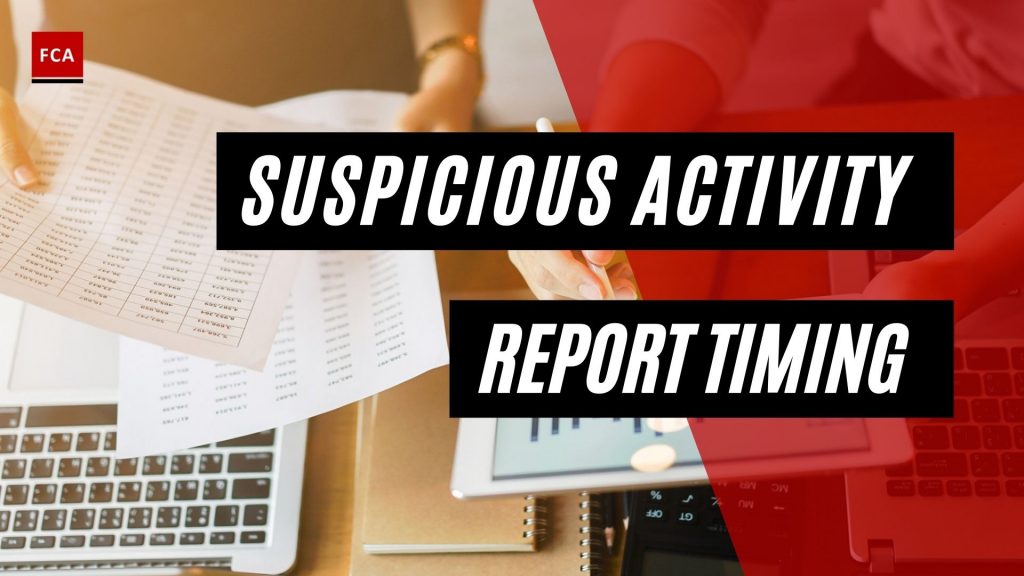Usually, suspicious activity report timing needs to be filed promptly, which means without an undue delay. Specific times may differ from jurisdiction to jurisdiction, but a good practice is 24 or 48 hours after it is clear that a SAR needs to be filed. It is important to emphasize that it is not necessary to file immediately but promptly.
Suspicious Activity Report Timing
The difference is that you also need the time to search for all information, collect the documents, and write the SAR. In the US, A SAR is required to be filed no later than 30 calendar days after the date of initial detection of facts that may constitute a basis for filing a SAR.
The phrase “initial detection” should not be interpreted as meaning when a transaction is highlighted for review in a financial institution’s transaction monitoring system. Various legitimate transactions could raise a red flag simply because they are inconsistent with an accountholder’s normal account activity. For example, a real estate investment, the receipt of an inheritance, or a gift, may cause an account to have a significant credit or debit that would be inconsistent with typical account activity.
The financial institution’s automated account monitoring system or initial discovery of information, such as system-generated reports, may flag the transaction; however, this should not be considered initial detection of potentially suspicious activity. The 30-day or 60-day period does not begin until an appropriate review is conducted. A determination is made that the transaction under review is “suspicious” within the meaning of the SAR regulation.
The bottom line is that a financial institution must have reasonable procedures and processes to identify potentially suspicious activity. When they do this, SAR filing’s timeframe does not begin until the financial institution conducts a formal review of the transaction and determines it to be suspicious. Once determined, the timeframe for SAR filing begins.
However, there is almost always an exception to the rule. In some cases, even 24 or 48 hours may be too long for information to reach the FIU. For example, a case of terrorist financing may require an immediate call to the FIU, so they can monitor the situation while the SAR is written. Some jurisdictions have normal SARs and priority SARs. Priority SARs make the FIU aware of the urgency of the matter. Even if your jurisdiction has priority SARs, a call can make many things faster and easier.

SAR Completion And Filing
The completion and filing of SARs is an important part of the SAR monitoring and reporting process. Appropriate policies, procedures, and processes should be in place to ensure that SARs are filed on time, are complete and accurate, and the narrative provides a sufficient description of the activity reported as well as the basis for filing. FinCEN created a new electronic BSA Suspicious Activity Report (BSAR) form, which replaced FinCEN SAR-DI form TD F 90-22.47. The BSAR standardizes data collection formats that can be used across industries. The BSAR became mandatory on April 1, 2013, and must be filed through FinCEN’s BSA E-Filing System. The BSAR does not create or alter existing statutory and regulatory requirements for banks.
A number of additional data elements pertaining to the type of suspicious activity and the financial services involved are included in the BSAR. For technical filing purposes, certain fields in the BSAR are marked as “critical.” This means that the BSA E-Filing System will not accept filings that leave these fields blank. The bank must either provide the requested information or check the “unknown” box next to each critical field for these items. Regardless of whether the individual fields are deemed critical for technical filing purposes, banks should provide the most complete filing information available in accordance with existing regulatory expectations.
As part of their case reviews, banks should report any information that they are aware of or that comes to their attention. Aside from the critical fields, the addition of new and expanded data elements does not imply that banks will revise or develop new programs to capture information that reflects the expanded lists. For more information on filing through the BSA E-Filing System, see Appendix T.
Timing Of A SAR Filing
The SAR rules require that a SAR be electronically filed through the BSA E-Filing System within 30 calendar days of the initial discovery of facts that may constitute a basis for filing a SAR. If no suspect is found, the time limit for filing a SAR is extended to 60 days. To determine whether to file a SAR, organizations may need to review transaction or account activity for a customer.
The need for a review of customer activity or transactions does not always necessitate the filing of a SAR. The time period for filing a SAR begins when the organization knows or has reason to suspect that the activity or transactions under review meet one or more of the definitions of suspicious activity, whether during its review or due to other factors.
The term “initial detection” should not be taken to mean the moment a transaction is highlighted for review. A number of legitimate transactions may raise a red flag simply because they are inconsistent with an accountholder’s normal account activity. A real estate investment (purchase or sale), an inheritance, or a gift, for example, may cause an account to have a significant credit or debit that is inconsistent with typical account activity.
The bank’s automated account monitoring system or initial discovery of information, such as system-generated reports, may flag the transaction; however, this should not be regarded as initial detection of potentially suspicious activity. The 30-day (or 60-day) period does not begin until an appropriate review is conducted and it is determined that the transaction under review is “suspicious” under the SAR regulation.
SAR Quality
SARs must be complete, thorough, and timely filed by banks. On the SAR, banks should include all known subject information. The significance of this information’s accuracy cannot be overstated. Inaccurate information on the SAR, or a disorganized or incomplete narrative, may make further analysis difficult, if not impossible. However, there may be legitimate reasons why certain information should not be included in a SAR, such as when the filer lacks the necessary information. A thorough and complete narrative may make the difference in determining whether law enforcement understands the described conduct and its possible criminal nature.
Because the SAR narrative section is the only area summarizing suspicious activity, it is designated as “critical” on the SAR. As a result, failing to adequately describe the factors that make a transaction or activity suspicious undermines the SAR’s purpose.
FinCEN issues advisories and guidance containing examples of “red flags” to inform and assist banks in reporting suspected money laundering, terrorist financing, and fraud. FinCEN requests that banks check the appropriate box(es) in the Suspicious Activity Information section and include certain key terms in the narrative section of the SAR in order to assist law enforcement in its efforts to target these activities. FinCEN’s website contains the advisories and guidance.
Notifying Board Of Directors Of SAR Filings
Banks are required by their federal banking agency’s SAR regulations to notify the board of directors or an appropriate board committee that SARs have been filed. However, the regulations do not specify a specific notification format, and banks should be free to design their own. As a result, banks may provide actual copies of SARs to the board of directors or a board committee, but they are not required to do so.
Banks may also provide summary reports, tables of SARs filed for specific violation types, or other forms of notification. Regardless of the format used by the bank, management should provide sufficient information on its SAR filings to the board of directors or an appropriate committee in order to fulfill its fiduciary duties, while keeping the confidential nature of the SAR in mind.
Record Retention and Supporting Documentation
Banks must keep copies of SARs and supporting documentation for five years from the date the SAR was filed. The bank may keep copies on paper or electronically. Furthermore, upon request from FinCEN or another appropriate law enforcement or federal banking agency, banks must provide all documentation supporting the filing of a SAR. “Supporting documentation” refers to any documents or records that assisted a bank in determining whether or not a particular activity required a SAR filing. There is no need for a legal process to be followed in order to disclose supporting documentation to FinCEN or another appropriate law enforcement or federal banking agency.
Final Thoughts
A financial institution must file a suspicious activity report no later than 30 calendar days after the initial discovery of facts that may constitute a basis for filing a suspicious activity report. If no suspect was identified on the date the incident requiring the filing was discovered, a financial institution may postpone filing a suspicious activity report for an additional 30 calendar days in order to identify a suspect. Reporting must not be delayed for more than 60 calendar days after the initial detection of a reportable transaction.
No bank, nor any director, officer, employee, or agent of a bank, may notify any person involved in the transaction that the transaction has been reported. Except as required to fulfill BSA obligations and responsibilities, a SAR and any information that would reveal the existence of a SAR are kept confidential. For example, the existence or even non-existence of a SAR, as well as the information contained in the SAR to the extent that the information would reveal the existence of a SAR, must be kept confidential. Furthermore, FinCEN and the federal banking agencies believe that a bank’s internal controls for filing SARs should minimize disclosure risks.








